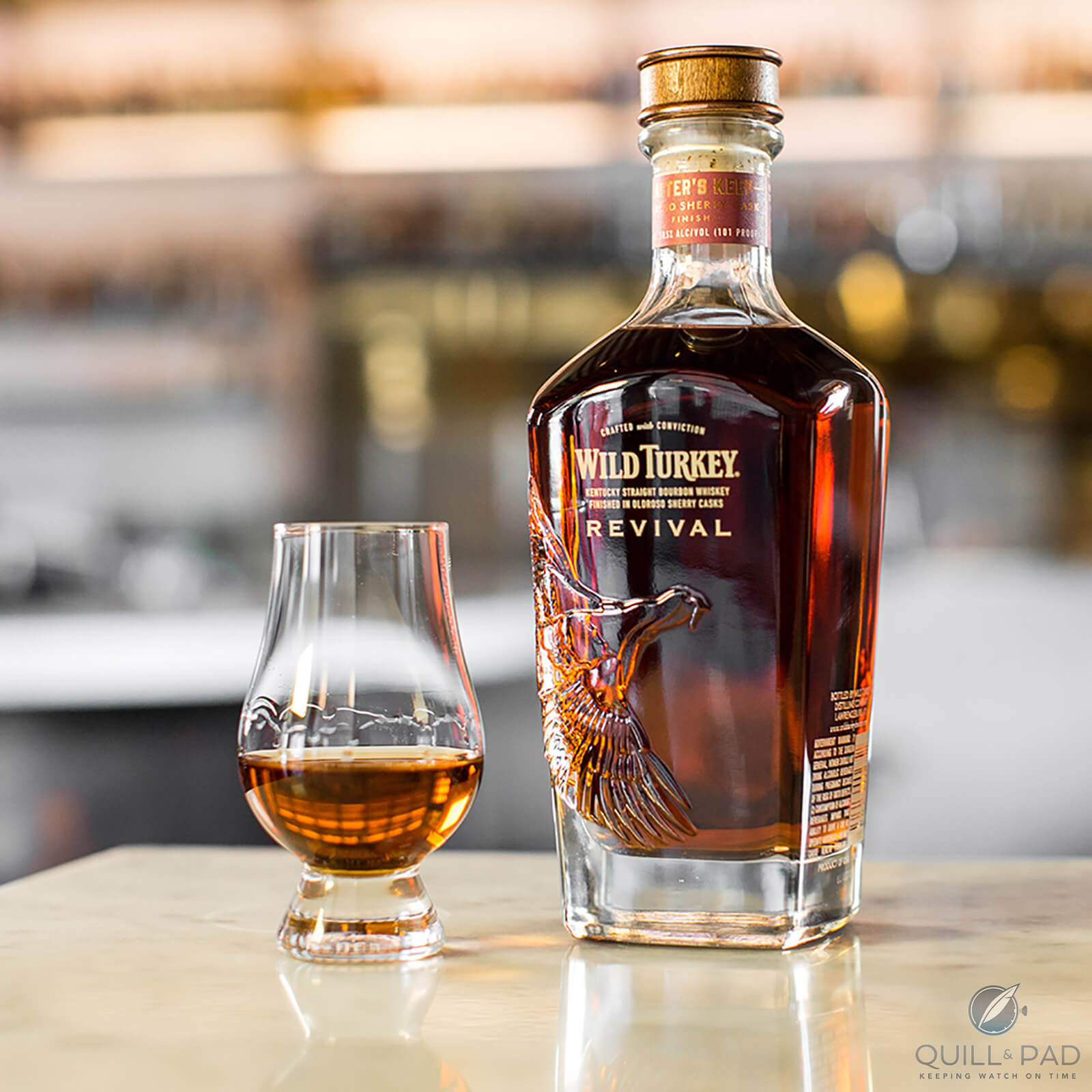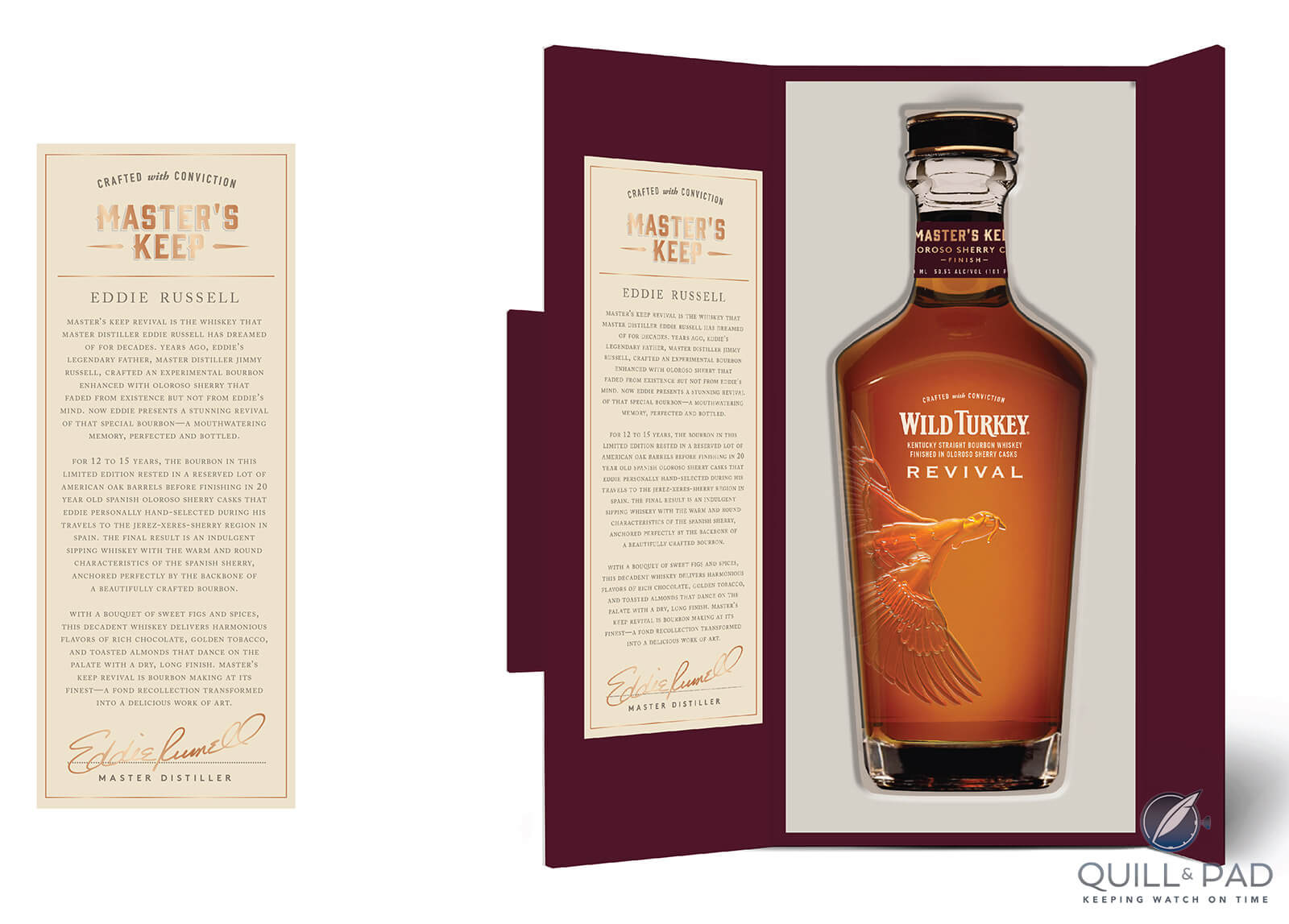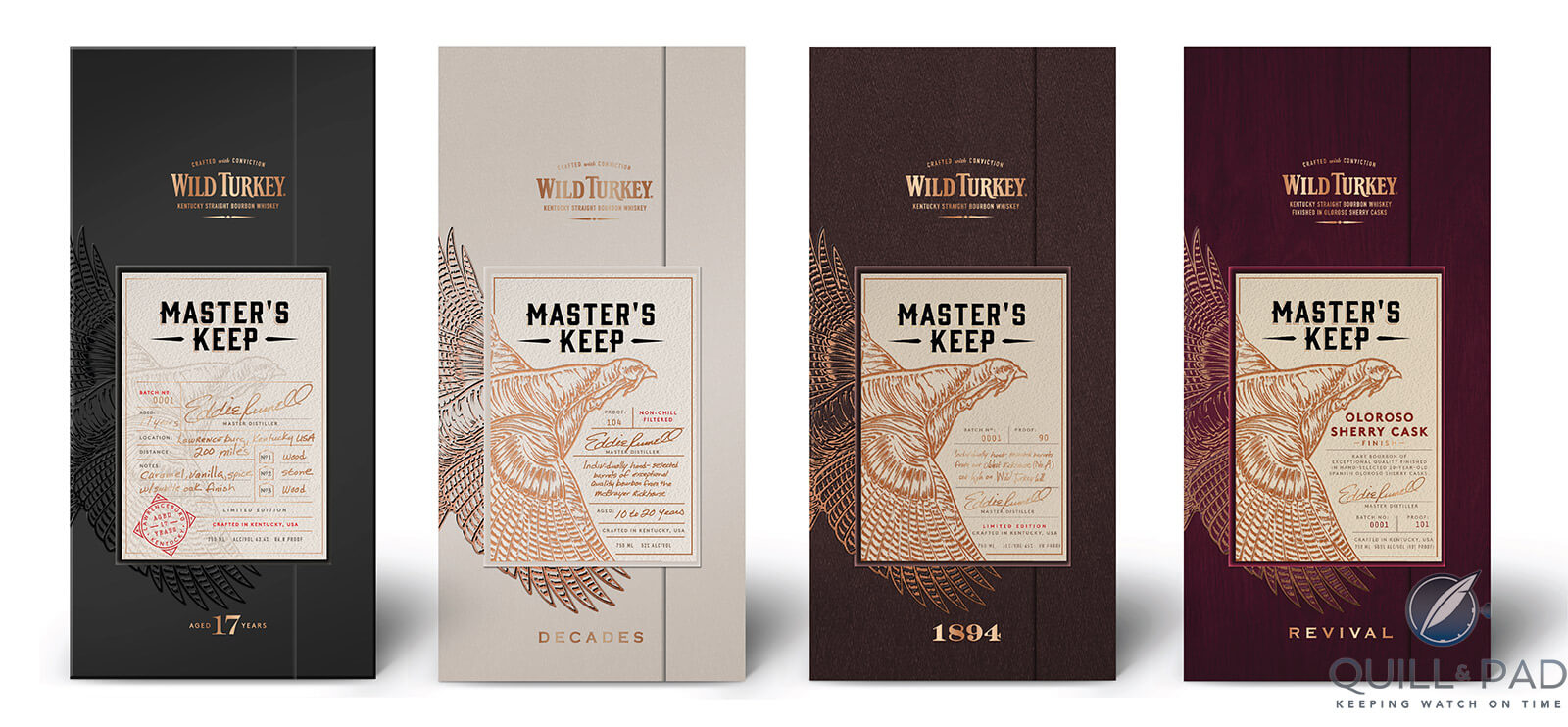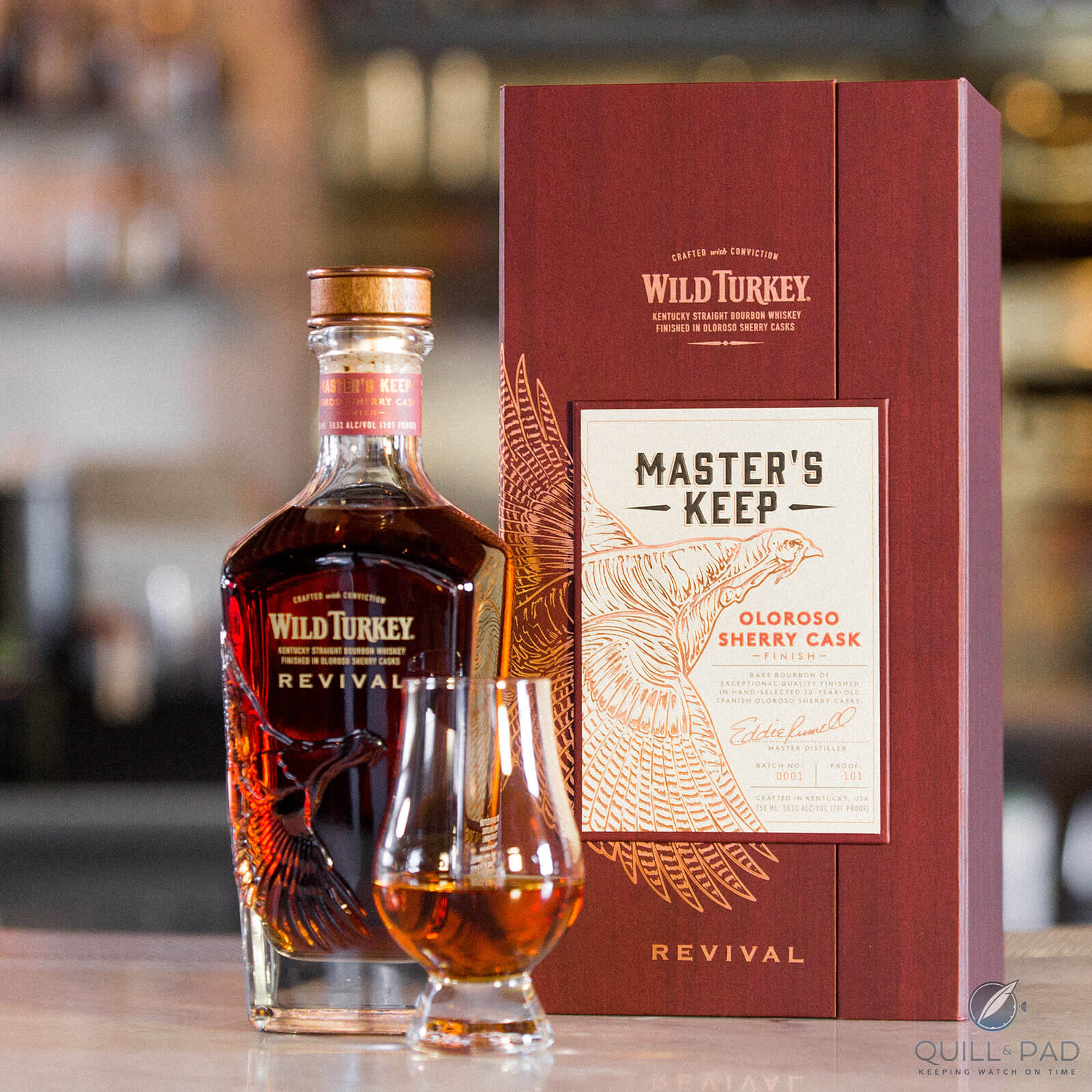Wild Turkey Master’s Keep: A Great Bourbon For Drinking Now
by Ken Gargett
It is amazing how often big is considered bad when it comes to wines and spirits. Moët et Chandon has suffered from this for years.
Large spirits producers also cop the brunt, and Wild Turkey is one of those. Make truckloads of something and apparently there is no way you can do it well.
Of course, if you are making truckloads then there is every chance you have a loyal market that really doesn’t care what others think: “101,” “Rare Breed,” “Rye,” and more are all expressions of whiskey and bourbon with legions of fans. These are whiskies/bourbons considered to be excellent value.
That said, it never hurts to ensure that your reputation and legacy is of the highest order. That can be done by slowly and gradually working to increase the quality of your core product (you need to move slowly here as too dramatic a change might lose you your current customers); by winning trophies, medals, and bling of any nature; by endorsement, these days usually by the appropriate celebrity; perhaps by introducing new, high-quality products to the range, such as limited editions, specials releases, rare bottlings, and so forth; or a combination of the above.
Wild Turkey has involved actor Matthew McConaughey (for me, perhaps the bravest man in America, growing up a lifelong Redskins fan in the middle of Cowboy country – NFL fans will understand, others may not).
But for me, it is tasting some of the high-quality bourbons that have emerged in recent years that confirm Wild Turkey to be a distillery worthy of serious consideration.

Wild Turkey Master’s Keep Revival
The Master’s Keep series has, or is about to, see its fifth release, Cornerstone Rye. The Wild Turkey website lists this as just the fourth release, but I think that it doesn’t include the “1894,” which seems to have been a Master’s Keep limited to Australia.
When you get this will depend on your location: it has already hit the shelves in America but is still several months off in some other markets. The previous releases would suggest that if you enjoy good whiskey/bourbon, make sure you get hold of it.
It is worth mentioning that one of the great advantages of these premium releases from Wild Turkey is that they are not prohibitively priced (these bourbons are in the vicinity of $175/AUD$200 per bottle), nor are they so limited that you’ll only ever read about them and never see a bottle. These are great bourbons intended for drinking.
Master distiller, the legendary Eddie Russell, has been quoted as saying that Master’s Keep was never intended as an ongoing series, but rather a one-off. However, Wild Turkey loved the bottle design and the decision was made.

Wild Turkey Master’s Keep Revival
A little about Wild Turkey
Perhaps a little on Wild Turkey before we look at the Master’s Keep series.
Go back to the Whiskey Rebellion of the late 1700s. Many whiskey producers left the northeastern United States and moved to places like Kentucky – perfect timing with Kentucky becoming the fifteenth state in the union in 1792, but it wasn’t till 1840 that the name “bourbon” became official – the production of Bourbon County.
Add to this the influx of Scottish and Irish fleeing the oppressive taxes imposed on producers, which ensured expertise and customers for the end product.
The Ripy family, whose endeavors would lead to Wild Turkey, arrived from Ireland in 1851. They built their distillery in 1869 in the shadow of Wild Turkey Hill in Lawrenceburg, Kentucky, though that was not where the name came from.
By 1873, the distillery was mashing 1,200 bushels of corn. Then, in 1893, more than 400 whiskeys were submitted to represent Kentucky in an international competition. It was a whiskey made by the Ripy brothers that was selected.
Production continued until the scourge of drinking in America arrived in 1919: Prohibition.
After repeal in 1933, the Ripy family was ready to recommence making its famous bourbon and took the opportunity to revitalize and modernize production.
The brand name is said to have come about in 1940 when one of the distillery executives, Thomas McCarthy, went on a hunting trip with friends, chasing wild turkeys. McCarthy brought along some warehouse samples for the trip, which were a hit.
The following year, his friends insisted he bring along “some of that wild turkey whiskey.” The name stuck.
In 1954, Jimmy Russell joined the company and became master distiller and brand ambassador. His son, Eddie, has been with the company for many years as well, taking over from his father. Since 2009, Wild Turkey has been part of the Campari Group.
Wild Turkey: a cultural icon
The fame of Wild Turkey goes beyond the mere contents of a bottle.
Any fan of Hunter S. Thompson will be all too aware of his predilection for it, mentioning Wild Turkey in several of his books, including the wonderful Fear and Loathing in Las Vegas and also Fear and Loathing on the Campaign Trail.
Musicians have drawn even more inspiration from Wild Turkey – it was the name of a 1982 top-ten country hit by Lacy J. Dalton. Jerry Jeff Walker, ZZ Top, the Cowboy Junkies, and George Thorogood are among many others to have mentioned it in song.
Films, too – Rambo, In the Heat of the Night, The Eiger Sanction, The Color of Money, Monster’s Ball, Thelma & Louise, and even Who Framed Roger Rabbit to name just a few.
Toss in the small screen, appearing in shows such as “NCIS,” “The Sopranos,” “Seinfeld,” “True Blood,” “Frasier,” and perhaps rather curiously, “Buffy, the Vampire Slayer” among so many more.
The percentage of corn used is part of the distiller’s private formula. The corn comes from Kentucky, the barley from Montana, and the rye from North Dakota.
The water used is limestone filtered, freeing it from any iron or mineral influence that may impact the flavor.
Wild Turkey uses the “sour mash” process, whereby yeast from a previous mash is used for the fresh fermentation. After fermentation, the liquid mash is pumped into a 40-foot-high continuous still and then into a “doubler” for a second fermentation to ensure the bourbon is as smooth as possible.
The distilled product then goes into new, charred, white oak barrels (with at least 26 staves in every barrel), assembled in Kentucky but from the Ozark Mountains of Missouri. These barrels are only ever used on a single occasion for Wild Turkey.
After that, they are sold to other producers to make Canadian, Irish, and Scottish whiskies. The barrels are then left to mature in one of the 20 warehouses existing solely for this purpose. Each warehouse houses 20,000 barrels.
After two years, tasting begins. Each barrel is tasted regularly, and detailed records maintained, to monitor its progress. When considered ready, the individual barrels are included in the blend.
Wild Turkey Master’s Keep
The Master’s Keep series involves a range of styles. As an example, the distillers may look to take whiskies aged 12 to 15 years in oak, then finished in oloroso sherry casks – which makes the 1894. Wild Turkey believes this process imbues the bourbon with “dessert-like flavors, including cherry pie, toffee, and sweet tropical fruit.”

Wild Turkey Master’s Keep collection
Previous releases include a 17-Year-Old, Decades, the 1894, and the Revival.
The 17-Year-Old is self-explanatory. “Revival,” which was limited to 10,000 bottles (or 20,000, depending on the source – a blend from 60 barrels, so that should give you a clue), was a tribute to master distiller Jimmy Russell and his 64 years at Wild Turkey.
Certain releases are apparently only available in Australia – I have not been able to get a clear explanation as to why. The 1894, which is one, had Eddie Russell traveling to Jerez, Spain to source old oloroso barrels for further aging after the young bourbon had spent 12 to 15 years in new charred American oak.
The name comes from the fact that this was the year in which Wild Turkey’s oldest rickhouse (the storage space for whiskey barrels during aging) was constructed, Rickhouse A.
Russell has been quoted saying that the bourbon there was the best he’d seen and, hence, the release. “From the very first taste at Rickhouse A, I knew I wanted to dedicate my life to bourbon.” Must have been one hell of a bourbon!
“Decades” was a blend aged between 10 and 20 years.
I’ve seen the 1894 and Revival, and if the others are of a similar quality then this is fast establishing itself as an exceptional line of bourbon.
For me, the 1894 is the more subtle of the pair. There are spice touches, hints of caramel, gentle kid leather and vanilla pod, some cedary oak impressions. Nicely balanced and quite refined, almost muted. An elegant bourbon. Early reports suggest Cornerstone Rye might be not too dissimilar.

Wild Turkey Master’s Keep Revival
Revival is all about bold, in-your-face flavors. This is rich and powerful. Much darker in color, more spirity, notes of lanolin, fudge, orange liqueur and smoke. Even a hint of fish oil in the nicest way.
There are good vanillin oak notes, plenty of complexity and a delicious nutty, nougat finish. Loved this, but there are occasions when the elegance of the 1894 is called for.
The Cornerstone, a rye, is eagerly awaited. Anyone who still thinks Wild Turkey is nothing but mass-produced alcohol needs to have a serious rethink.
For more information, please visit www.wildturkeybourbon.com.
You may also enjoy:
Michter’s Kentucky Bourbon (Plus The Difference Between Whiskey, Whisky, And Bourbon)
Sullivans Cove Makes The Self-Professed World’s Best Single-Malt Whisky, But Does It Measure Up?
Buffalo Trace Antique Collection Bourbon: Cult Treasure
Yamazaki 12-Year-Old Japanese Whisky: Why Pricing Has Gone Through The Roof



Leave a Reply
Want to join the discussion?Feel free to contribute!